Obviously, this is a topic that could fill many volumes of books. In this article, I am going to hit on the highlights as they relate to the latest research on this important subject.
In nutshell, the more compatible you are, the longer the relationship will last.
Compatible means you have similar personality traits and values – the more the better.
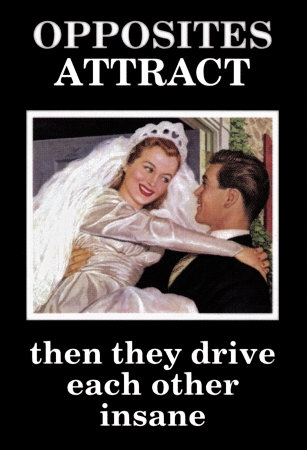 That may seem like a no-brainer, but think how “opposites” so often attract.
That may seem like a no-brainer, but think how “opposites” so often attract.
A lot of us are sexually attracted to opposites.
A tall person may be attracted to a short one. If we are wild, we may be attracted to conservative. Quiet may attract loud.
Sometimes opposites do attract us initially, but what often happens is that there is not longevity. The relationship does not last the long haul.
You’ve seen a movie star with someone much quieter in the background because one person gets the attention and the other stays out of the limelight.
Those relationships are based on complementary traits. They complement each other.
If someone has a huge desire for attention, it may be nice for their partner to have a supporting role, like a cast in a movie, the lead and the supporting actor.
It is great to be complementary… at first.
But, statistically speaking, you will do better over the long haul with core traits that are similar.
You can look at a lot of the core traits in handwriting to determine compatibility.
In this article, I am going to explore one core trait in depth as it relates to compatibility.
Emotional Outlay
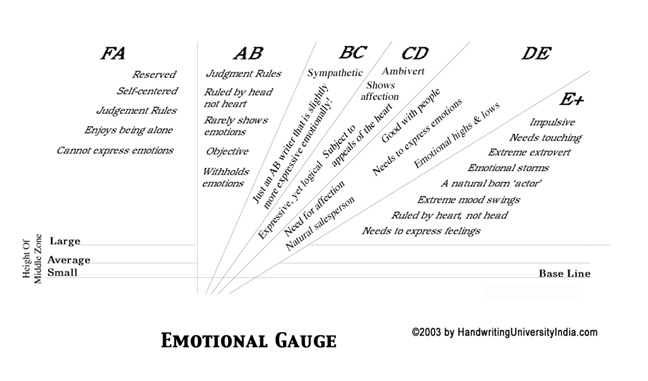
Emotionally outlay is a core trait that is basically revealed by measuring the slant of the writing.
If you both slant to the right, that’s going to be a naturally more affable, warmer, and fuzzier match.
I get a lot of questions from people who have different slants of handwriting from their mate.
Take, for example, Sue and Don.
She’s a straight up and down writer, an A-B even an FA write. She’s very grounded with logic and might even have a fear of expressing emotions. Cool. Cold. Calculated.
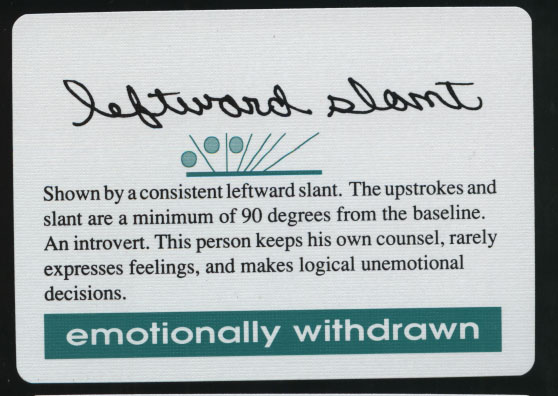
(201 Trait Dictionary owners: click here to learn more about the A-B Slant personality trait). If you do not have access to the 201 Trait dictionary, click here to get registered for full access.
His handwriting is more of a right-handed slant. He’s emotional.
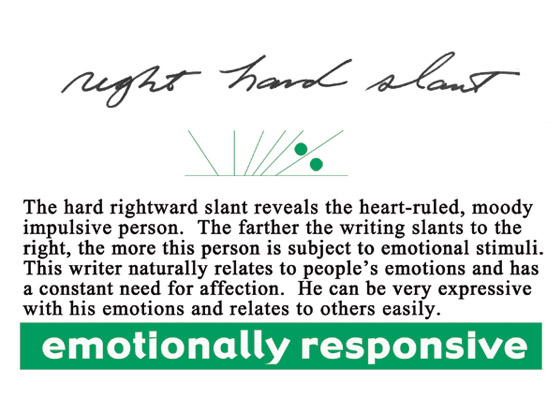
(201 Trait Dictionary owners: click here to learn more about the right-handed slant trait) If you do not have access to the 201 Trait dictionary, click here to get registered for full access.
The question Sue asked: “Are we compatible?”
Sadly, I have to say that in my experience, I’ve rarely seen relationships with completely different slants last for an extended period of time.
There was one exception that I used to use in my seminars: Darrel and Suzanne.
They were opposites who seemed to have found a way to work out their different ways of being.
He was an essay writer and computer programmer, and his handwriting slanted backwards.
She, too, was a writer and also a motivational speaker, and her handwriting slanted forward.
They had a really beautiful marriage from the outside (for a while).
As you got to know them, what you realized was that she actually travelled the country doing self-help seminars every weekend.
He loved being alone. So, he relished the time she was away because he got his alone time. He also loved when she was around because she was like a breath of fresh air.
Problem was, she could not get her needs met from him.
After about seven years, their relationship ended.
Now I can’t think of a single example of a long-term relationship that has continued when one person has FA slant the other person has a DE… not one.
What ends up happening is if you don’t have the same emotional outlay, you don’t connect on the same level.
 For example, if you see an injured dog on the side road, the person with the handwriting slant to the right will have much more empathy and action for that dog than the person who slants to the left. Feeling loved is one step after expressing love. Now, while an injured dog might not cause a fight… decisions about money, family, cousins, and how much “truth” one is expected to share will make a big impact. Emotional expressiveness is a key to feeling loved.
For example, if you see an injured dog on the side road, the person with the handwriting slant to the right will have much more empathy and action for that dog than the person who slants to the left. Feeling loved is one step after expressing love. Now, while an injured dog might not cause a fight… decisions about money, family, cousins, and how much “truth” one is expected to share will make a big impact. Emotional expressiveness is a key to feeling loved.
Over time, that can cause conflict and erosion of the relationship.
Another example might be if a friend is in need and you want to get up one night to go help her, the more logical person will say, “Why are you doing that?”
And, when it really becomes a problem is when you are expressing your love.
People with a backwards slant or straight up and down writing are less likely to say the words, “I love you.” They will tend to express their feelings nonverbally. Their feelings remain a little more pent up.
So, if you don’t have the same slant, you might not understand each other. You are likely to run into communication problems.
As Dr. Phil says, “The big thing is you’ve got to talk in a relationship. You got to talk to each other. That’s the secret to a relationship.”
And, if you both have similar slants in your handwriting, you are more likely to “speak the same language.”
Communication is the key.
Sarcasm, Hostility, Resentment… Urgh!
In 2005, Malcolm Gladwell published a fascinating book, Blink: The Power of Thinking without Thinking. It is just a little book, a fantastic read and one of my favorites.
It is about how your intuition is really smarter than you might know.
Gladwell is a psychologist and a sociologist who has researched all kinds of sociological patterns.
In this book, he actually talks about certain relationships. He talks about some interesting research studies on relationships.
In one study, they monitored couples communicating about an important topic for about ten minutes. They video-taped it and measure heart rate and pulse. They examined eye movements.
Then, they ran all the data through a computer.
Using his “magic formula,” he was able to successfully predict whether a couple would be together seven years from now with 85% accuracy.
What he noticed was that the couples who had covert hostility (sarcasm) present in their conversations, when one person was more dominant than the other in a way that caused hostility, then those couples were the ones that ended up having all the negative marks on their personality report.
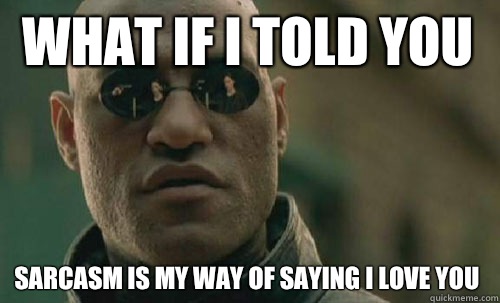
No matter how nice one of the members of the couple was, if the other one was hostile, angry, resentful, or even a little bit guilt-ridden, then that couple was more likely to fall into the pool of people who would end up getting divorced.
What does that teach us?
Obviously, it teaches us that if you are in a relationship with a predominant trait of hostility, anger, or annoyance…, or if one partner is uncompromising or stubborn, your chance of the relationship failing is dramatically higher than of its succeeding.
Think about that. How would you deal with that?
Most of you reading this article, you are the nice one. Most of you are reading books, learning about yourselves, self-improving.
You are a good person. You want to be loved. And, you want to avoid someone who is secretly going to leave, cheat on you, or somehow be hostile.
The Secret:
You either change yourself to become more like you want because then you’ll attract that into your life…
Or, you have to be analytical enough to spot the people who have hidden hostility traits and not go with them. Stop yourself from falling in love with them and from dating them right from the beginning.
That’s vital to a good relationship.
Summary
The key to a good relationship is similarity and compatibility in personality traits.
The key to a long relationship is finding people without toxic traits such as hostility, anger, resentment, stingers, etc.
The most important aspect of a long-term relationship relates to what emotions you value most. In NLP, we call this Values Elicitation. When your values are aligned, you can overlook quite a few personality incongruences.
Figure out what is important to you in a relationship.
What are your top five values? Know what is important to you. The new course Unstoppable You has a full one hour lecture and exercise on eliciting your values and why this is significant. http://unstoppableyou.net
If you are on a budget, you can download Bart’s first book which covers the SLANT and the process of eliciting values in great depth for under $10. PDF file.
Then, after you’ve successfully elicited a potential mate’s core values, look at what matches up (assuming that their handwriting does not reveal that they are a complete mess because if it does, all bets are off, and you really should not even date that person).
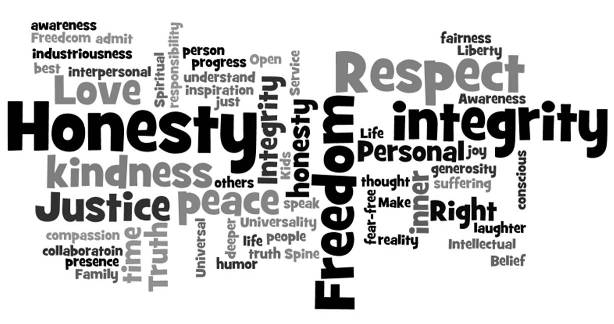
If you do not share at least two of the top five, then you are probably doomed.
If you find you have three of the five in common, you have a good chance.
If you have four of the top five? Get married right now!
If you have five of the five, you’ve got a great chance for a solid, long-term relationship.
note. Compatibility is a difficult formula to master. You must be at the 301
level “skill” in handwriting analysis and have many hundreds of analysis under your belt.

------------ Special Newsletter Reader Offer ------------

Visit the discount page now.

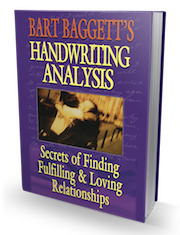
Permalink
Both of my step sisters have hand writing that slants to the left, but both of them are VERY expressive with their emotions, especially positive happy ones. But they express negative ones too from time to time.
I’ve seen this trait actually in a lot of retail managers – that their hands writing slants left too, yet they are fairly upbeat people. And they are good with other people.
Could that trait, instead of signifying that someone is emotionally withdrawn, signify something different given these observations?
Permalink
Nicole,
That’s a great question. The answer lies in two features which this article does not explore, but the home study course delves deeply into these aspects. Here is a summary.
1. The overall SIZE of the middle zone is a huge contributing factor to someone being friendly and expressing. If your sisters have a LARGE middle zone, then they will be very friendly, regardless of the slant.
2. Measuring slant is not as easy as it looks. You can’t really measure printing and you never use upstrokes to measure slant. So, even in our live seminars over 20% of the participants are off by “one slant” or more when they first use the emotional guage and very off if they just EYEBALL it. So, in other words, I am saying that you “think you see backwards slants” at work all the time, but if you measured these people’s writing using the exact procedure outlined in the LEVEL 101 and tool the middle zone size into consideration, these people would not have FA slants.
Good question. Every time you give a blanket personality description from just one state and fail to “stack” the others, you run the risk of having expections and not being totally right. However, when writing articles for the general public we must use the primary traits to keep it simple for those people who are not yet enrolled into the home study course.